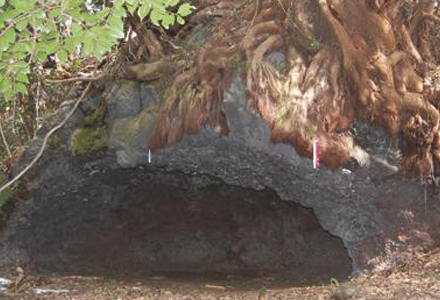During Jeju 4·3, the residents of Uigwi-ri village experienced severe oppression due to the initial hardline suppression by the army-police counterinsurgency forces. To survive, the villagers had no choice but to hide in nearby oreum (small volcanic cones), forests or caves. Many residents who were arrested were later either killed or sent to prisons on the Korean mainland. The majority of the victims are still missing, without any information on whether they survived or lost their lives.


Uigwi Elementary School
Uigwi Elementary School was where children from Uigwi, Sumang, Hannam and Sinheung villages studied together until Jeju 4·3 broke out. From Dec. 26, 1948 (in the midst of the uprising and massacre), B Company, 1st Battalion, 2nd Regiment of the Army was stationed in the school.
Early in the morning of Jan. 12, 1949, an armed guerilla unit attacked the school, resulting in the deaths of four soldiers and 51 guerillas. In retaliation, the army murdered some 80 villagers (who had been detained in the school at that time) in the field east of the school grounds. The victims are now buried in the Hyeonui Collective Cemetery.

Hyeonui Collective Cemetery
The Hyeonui Collective Cemetery enshrines more than 80 innocent victims who were killed by counterinsurgency forces stationed in Uigwi Elementary School during Jeju 4·3. In 1983, a tombstone was erected in memoriam of the righteous souls and a memorial ceremony has been held here every Aug. 14 of the lunar calendar.

Former Songnyeongigol District
The armed guerillas who died during the battle at Uigwi Elementary School were buried in the site pictured. Early in the morning of Jan. 12, 1949, armed guerillas attacked counterinsurgency forces stationed at the school but retreated with 51 casualties following the two-hour battle. The dead guerillas were left barely covered with soil in the backyard of the school. In the spring, the counterinsurgency forces relocated the bodies to the current burial site.

Minoreum (Yeonggweomoru) Military Base
In 1952, a combat police unit created to arrest guerillas hiding in the mountainous areas staged a suppression operation from its Minoreum (a small volcanic cone in the northeastern area) military base to crack down on the remaining armed guerillas.

Yeonggwe Cliff Cave
Yeonggwe is where Uigwi villagers hid to avoid hardline suppression operations by the counterinsurgency forces during Jeju 4·3. According to testimony, the villagers couldn’t stay in the cave for long due to its wide entrance that could be easily seen. For short periods of time, however, the cave provided shelter from the cold and rain.